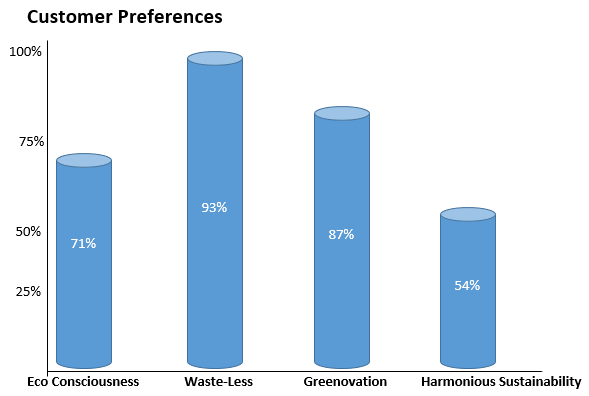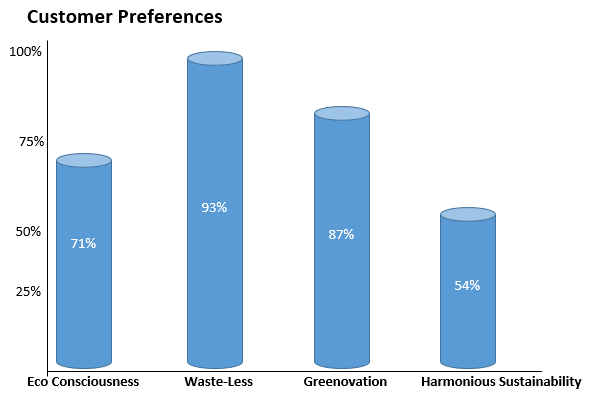Leaving behind the gloom of the pandemic years, the quick-service restaurant (QSR) industry is making a comeback. With a projected market size of US$293.8 billion in 2023 (source: globonewswire) the industry is expected to grow to US$454.3 billion by 2030 in the US
Growth is largely driven by QSR participants adapting to new consumer preferences. Consumers are now largely concerned about their health, look for sanitized spaces, prefer technological solutions, consider environmental and economic costs and, above all, expect an excellent QSR experience.
If you are in the QSR business, you must consider changing consumer preferences when designing spaces for your QSR architecture.
1. Understanding changing consumer preferences
For most restaurants, the QSR experience is a lifeline for business. It is the experience that restaurants provide to their customers to attract them. Adopting current trends and consumer preferences will help improve the QSR experience.
Current trends and changes in consumer preferences
● Reimagine interiors – Changing interiors every three to five years is a norm in the quick-service restaurant industry. And the 'new image project' is a raging trend in the QSR industry. As the name suggests, it involves reimagining the entire QSR space by replacing existing equipment, bringing in digital solutions, updating software systems and giving a refreshing look to the interiors.
● Preference for online ordering – According to a study by Gloria Food (source: gloriafood) , 86% of Americans order food online at least once a month. Since the pandemic, consumer preference for online ordering has seen a significant increase and demand is increasing. Responding to demand, QSR brands have created their websites or apps for online ordering or partnered with third-party delivery services.
● Health conscious – Today’s consumer is highly health conscious and prudent in their food choices. There is a growing preference for organic foods and consumers expect QSR to display organic ingredients on the menu.
● Sustainable practices – Consumers are aware of climate change and its impact on the planet. Many prefer QSRs that follow sustainable practices such as responsible ingredient sourcing, eco-friendly packaging, waste reduction, etc.
2. Embracing flexible, multifunctional spaces
Changing consumer eating habits require flexible and flexible QSR design. It must provide convenience to the customer, integrate technology and customization options for the customer.
When designing the space, separating the drive-thru, take-away and dining areas will result in hassle-free movement of customers and quick service delivery. And there's a penchant among customers for QSRs with curbside pickup (source: oracle) . Therefore, it is essential to provide parking space for curbside pickup.
Additionally, with the rise of digital orders, QSR space must be flexible to process and deliver orders quickly. For example, Hot Chicken Royals (source: royalshotchicken) created labeled cubicles for several third-party services. When an order is received, the package is placed in the designated cubicle for the delivery person to pick up.
3. Incorporation of Technology and Digital Integration
Technology has become critical for rapid turnover. It enables fast service delivery, accurate order taking, automatic menu adjustments, data analysis, and more. Within a QSR space, there must be pathways to incorporate technology and integrate digital solutions.
The implementation of self-service kiosks will reduce pressure on cashiers and eliminate errors in order taking. Digital menus for drive-thru customers will help them choose food quickly. Mobile apps and websites will help in quick ordering and hassle-free payments. Additionally, using QR codes and other contactless payment solutions will increase customer satisfaction. All of this must be complemented with dedicated spaces within the overall architecture of the QSR.
4. Using Data and Analytics
Thanks to digital technologies, a quick-service restaurant now has access to vast amounts of data about consumer behavior and preferences. Leveraging data to design quick-service restaurant architecture becomes much more critical.
Using data analytics, major QSR brands have already dissected consumers' choices and desires. Using analytics, they discovered new pain points, made menu innovations, created optimized layouts, developed better inventory management systems, and improved their operational efficiency.
Data analytics therefore plays a key role in creating an informed QSR architecture.
5. Improve sustainability and environmental considerations
Consumers are now highly aware of environmental issues and seek out eco-friendly quick service restaurants. A restaurant design must therefore include environmentally friendly and reusable materials, energy-efficient systems, renewable energy sources, waste reduction strategies, efficient ingredient sourcing, innovative packaging solutions and effective supply chain management. Additionally, designing the space while aligning with environmental certifications and green building ratings such as LEED (source: usgbc) certification, National Green Building Standard ICC 700 (source: nahb) Globos Verdes (source: thegbi) certification, etc., will improve customer loyalty.
6. Creating engaging and memorable experiences
Digital technologies enable QSR brands to engage with customers and deliver a memorable dining experience. In-app personalization, order savings, menu suggestions, loyalty programs, etc. will keep customers engaged.
Designing a QSR architecture that focuses on customer convenience will help the brand create memorable customer experiences. Wayfinding signage, clear paths, touchless payment points, updated websites and apps, real-time menu changes, and providing accurate information all go a long way toward creating a memorable atmosphere and winning loyal customers.
7. Extracting insights from statistical data
Here are some statistical insights (source: oracle) into QSR industry trends and consumer preferences that should help you make informed decisions when designing QSR architecture.
● 71% of consumers are concerned about the environmental impact of restaurant operations. Consumers are particularly attracted to restaurants that use biodegradable packaging and commit to low emissions.
● For 93% of consumers, reducing food waste is a priority. And 87% of consumers seek transparency about a restaurant’s sustainability initiatives.
● Personalization is an important driver of customer loyalty. 55% of consumers are comfortable with personalized location-based offers. 45% love the idea of receiving personalized order suggestions based on their past purchase history.
● The click-and-collect drive-thru model is popular with consumers. Around 54% of US consumers prefer click-and-collect services.
 Source: Oracle.com
Source: Oracle.com
8. Collaborating with the right MEP engineers
Conclusion
The quick-service restaurant industry is undergoing a transformation driven by changing consumer preferences. Whether it's a health-conscious life or a preference for sustainable catering practices, QSR brands are adapting to change by integrating technologies, bringing refreshing QSR menu design, following sustainable practices and more. While navigating this transformation is challenging, it is largely rewarding for QSR brands in terms of customer retention and increased revenue.

